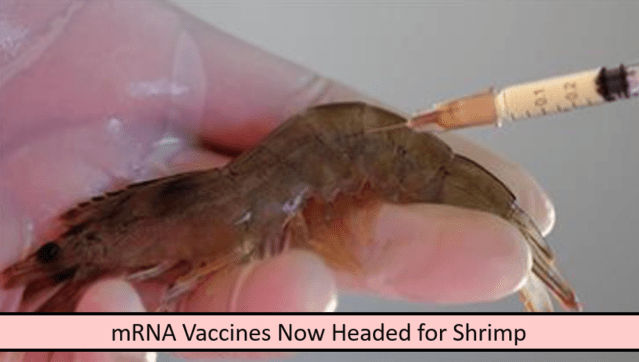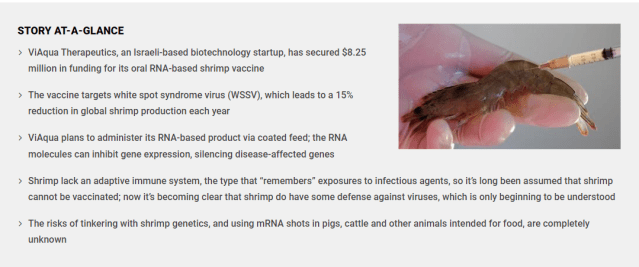mRNA Vaccines Now Headed for Shrimp.

Shrimp are slated to become the latest food source exposed to messenger ribonucleic acid (mRNA) vaccines, courtesy of ViAqua Therapeutics, an Israeli-based biotechnology startup. The company has secured $8.25 million in funding from venture capitalists for its oral RNA-based shrimp vaccine, which is intended to target white spot syndrome virus (WSSV), according to Dr. Mercola.
According to an analysis by Mercola there are plans to administer its RNA-based product via coated feed, he writes “ViAqua suggests the RNA molecules can inhibit gene expression, silencing disease-affected genes with every meal.1 WSSV is a devastating condition in shrimp, leading to a 15% reduction in global shrimp production each year — an annual loss of about $3 billion.”2
Dr Mercolas‘ analysis is below:

ViAqua says challenge tests show its RNA-based formulation improved shrimp survival against WSSV, but at what cost? The use of mRNA in the food supply is controversial for good reason — no one knows what the long-term consequences will be.
RNA Vaccines Coming for Shrimp
ViAqua is using RNA interference (RNAi) particles, provided as a feed supplement, to manipulate gene expression in shrimp, one of the most widely consumed forms of seafood worldwide. In a 2022 proof of concept study that used a polyanhydride nanoparticle delivery platform to deliver RNA to shrimp orally, it’s stated:3
“RNA interference (RNAi) in invertebrates is an antiviral cellular mechanism by which a trigger, such as double-stranded RNA (dsRNA) or small interfering RNA (siRNA) starts sequence-specific degradation of target mRNA, thereby preventing viral gene expression.
… In aquaculture systems, the concept of RNAi-based vaccines has been championed for several reasons: (a) RNAi works as an antiviral immune response in shrimp; (b) it is pathogen-specific; and (c) it generates a long-term protective immune response.”
The study found that the “nanovaccine” was about 80% effective in protecting against WSSV in shrimp, when administered via reverse gavage to “mimic an oral route.”4 ViAqua has brought the potential for oral delivery to the next level, with plans to begin producing its RNAi capsule products in India in 2024.5 Shai Ufaz, ViAqua’s chief executive officer, stated:6
“Oral delivery is the holy grail of aquaculture health development due to both the impossibility of vaccinating individual shrimp and its ability to substantially bring down the operational costs of disease management while improving outcomes … We are excited to bring this technology to market to address the need for affordable disease solutions in aquaculture.”
Can Shrimp Be Vaccinated?
Shrimp lack an adaptive immune system, the type that “remembers” exposures to infectious agents so it can mount a better response the next time it comes around. Because of this, it’s long been assumed that shrimp cannot be vaccinated. According to the Global Seafood Alliance:7
“Scientific literature on shrimp has often adopted terms and approaches from mammalian immunology, but not always in a correct way. Such is the case in the use of the term “vaccination” in crustaceans. The principle of vaccination is based on two key elements of the immune system: specificity and memory. These two properties are not recognized in the immune systems of shrimp and other invertebrates.”
However, while shrimp don’t have adaptive immunity in the traditional sense, it’s becoming clear that they do have some defense against viruses, which is only beginning to be understood. In 2008, researchers with Australia’s University of Queensland explained, “There is mounting evidence for specific immune memory in crustaceans, including shrimp,” adding:8
“It has been widely assumed that no such adaptive systems exist in invertebrates, thus vaccines have not been routinely developed and used in shrimp aquaculture. Invertebrates were considered to rely solely on an innate immune system characterized by generalized immune responses to conserved molecular structures of invading pathogens such as bacteria and fungi.
Some of these pathways are relatively well understood, involving an array of pattern recognition receptors interacting with serine proteases to initiate encapsulation, phagocytosis and an antimicrobial cascade based on the phenoloxidase enzyme system.
However, what is becoming more apparent is that the diversity and sophistication of innate responses in invertebrates is far greater than previously assumed. The invertebrate immune response to viruses is particularly poorly understood.”
ViAqua’s RNAi product claims to “enhance resistance to viral infections” in shrimp,9 and they have plans to develop additional mRNA vaccines for fish and other biotechnology products targeting additional shrimp viruses and other pathogens.10
But shrimp pathogens of one kind or another are virtually guaranteed to persist in the intensive aquaculture farms where many shrimp are raised. Further, the risks of tinkering with shrimp genetics are completely unknown.
mRNA Shots Already Used in Pork
The media has been pretty quiet about the up-and-coming genetic manipulation of shrimp. This seems to be par for the course. Few are aware that, since 2018, pork producers have been using customizable mRNA-based “vaccines” on their herds — as it largely slipped by under the radar.11
It wasn’t until attorney Tom Renz began promoting new legislation in Missouri (House Bill 1169,12 which he helped write) that would require labeling of mRNA products that it began to receive attention.13 In an April 1, 2023, tweet, Renz stated:14
“BREAKING NEWS: the lobbyists for the cattleman and pork associations in several states have CONFIRMED they WILL be using mRNA vaccines in pigs and cows THIS MONTH. WE MUST SUPPORT MISSOURI HB1169. It is LITERALLY the ONLY chance we have to prevent this … NO ONE knows the impacts of doing this but we are all potentially facing the risk of being a #DiedSuddenly if we don’t stop this.”
Even though the bill asks only for transparency — not a ban of the mRNA-based shots — industry pushback has been enormous. They don’t want you to know that they’re using mRNA and similar products, because then they’d have to admit that the resulting foods may have gene-altering effects. And it’s not just pork, either.
Cattle Groups Urge Caution Over mRNA
The first RNA-based livestock vaccine, a swine influenza (H3N2) RNA shot developed by Harrisvaccines was licensed in 2012.15 The company followed up with an avian influenza mRNA shot in 2015.16
Concerns that mRNA injections could end up “in the global protein supply chain” also prompted warnings from cattle producers and calls for mandatory country of origin labeling (MCOOL) so consumers can choose meat from countries that don’t allow mRNA shots in meat animals.17
In an April 2023 news release, Ranchers-Cattlemen Action Legal Fund United Stockgrowers of America (R-CALF USA), a nonprofit that represents interests of independent U.S. cattle producers, shared concerns about the use of mRNA shots in cattle and other meat animals. Max Thornsberry, DVM, R-CALF’s animal health committee chair, met with medial doctors and a molecular biologist before briefing the R-CALF USA board:18
“Thornsberry reported that some researchers have found that mRNA and its coded virus is likely passed from an injected human to a noninjected human, and to humans who have consumed dairy products or meat from an mRNA-injected animal.
He said that because the research on mRNA is still in its infancy, no one really knows the full impact it has on either humans or animals, particularly its long-term impact. He said this itself warrants more extensive mRNA research focused on safety, heightened public vigilance, and greater transparency.”
In a commentary, R-CALF CEO Bill Bullard also urged caution regarding mRNA injections, stating:19
“It’s not a vaccine as we typically understand vaccines. So, for the rest of this discussion, I’ll refer to it as an injection. It’s an injection of a laboratory-produced substance into humans or livestock that is coded with a particular virus, such as COVID-19, that produces an immune response against the particular virus.
And what does mRNA do? Well, it hijacks living cells, tricking them into producing some level of immunity against human viruses like COVID-19 and livestock viruses such as foot-and-mouth disease or lumpy skin disease. It does this by rewriting the instructions from the body’s DNA. And what are the potential risks to humans and livestock?
The truthful answer is we don’t yet know the long-term effects of mRNA injections in either humans or livestock.
… There is great concern that living cells excrete the mRNA over time and the mRNA can then be transferred to animals and humans that have never received the mRNA injection. It is believed, for example, that humans can contact mRNA by eating meat from livestock that have received the injection.
The reason mRNA is an issue today is that pharmaceutical firms have found that it takes very little of it to hijack a cell, and it can be produced cheaper than typical virus vaccines.”
Is it possible that mRNA or RNAi nanoparticles could persist in the meat and shrimp you’re eating? Penny Riggs, associate research professor of functional genetics at Texas A&M, stated, “The estimate is that half of the mRNA from a vaccine is gone in about 20 hours, and completely destroyed within a few days.”20
However, Thornsberry cited21 one study, published in Biomedicines, that found mRNA from injections can be detected in blood 15 days post-shot.22
The proof-of-concept study for the shrimp RNA nanovaccine also found the particles persisted long after administration: “The nanoparticles localized to tissue target replication sites for WSSV and persisted through 28 days post-administration.”23 Again, the consequences of consuming these nanoparticles remains to be seen.
Antibiotic Resistance Widespread in Shrimp
Farm-raised seafood is among the most contaminated foods you can eat, shrimp included. Antibiotics are commonly used on farmed shrimp in an attempt to slow down pathogens.24 Not surprisingly, shrimp is often contaminated with antibiotic-resistant bacteria as a result.
One investigation by CBC News Marketplace found 17% — nine of the 51 packages of shrimp imported from Vietnam, Thailand, China, India and Ecuador — were contaminated with antibiotic-resistant bacteria.25 Among them, all but one showed resistance to multiple antibiotics.
Investigators purchased imported shrimp labeled “organic” as well as some with the “Best Aquaculture Practices” certification, which maintains that farmers only use antibiotics minimally.
So, while shrimp can be a healthy addition to your diet, it’s important to avoid farm-raised shrimp, which is the type served in most restaurants and the variety that’s slated to receive a gene-altering nanoparticle vaccine in its feed. When it comes to purchasing high-quality shrimp, look for those that are either wild caught or locally produced.
Sources and References
Analysis by Dr. Joseph Mercola
This article has been archived for your research. The original version from The Exposé can be found here.



